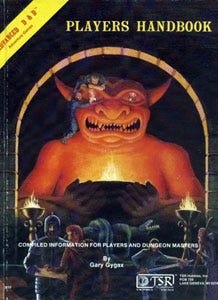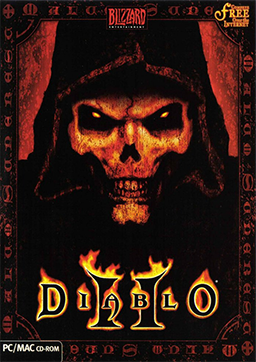
Featured Blog | This community-written post highlights the best of what the game industry has to offer. Read more like it on the Game Developer Blogs.
The Future of the ARPG
Shares some thoughts about the ARPG, how it came to be, how it has evolved and what the future might hold for the genre.

The Action Role Playing Game (ARPG) has grown into a game genre with its own integrity and uniqueness. Recent conversations with colleagues caused me to contemplate where this category is headed and in doing so, where it has been.
ARPG Prehistory

P&P RPGs
From my high school years on, I was a huge pen-and-paper (P&P) RPG enthusiast—it was essentially my gateway drug to becoming a professional game designer. D&D, in particular was a glorious mess with Byzantine system depths to explore, all fueled by imagination and social play. It was arguably the first true RPG and reached an audience of more than 20 million people.
I quickly moved from playing to creating campaigns, worlds, rule mods, and eventually full game systems. I parlayed what I was doing into a job, and then migrated into electronic gaming. It was always somewhere in the back of my head that I wanted to bring these experiences to life in the medium I was now working in.
CRPGs and JRPGs
I was far from the first: D&D remains one of the biggest influences on computer and video games to this day, but in the earlier days, perhaps even more so. Versions of RPGs had begun to appear in electronic form nearly as soon as those platforms came into being, and labelled Computer RPGs (CRPGs). The constraints of the medium were such that these games were very stripped down, and very little of what was awesome in P&Ps could shine through. Turn-based gameplay was one of the limitations that game creators had to accept.
The idea of mixi ng action elements into the RPG milieu appeared in Japan on consoles (hence the JRPG or Japanese RPG), where audiences wanted something less static than what had been offered in CRPGs to that point, where mostly text and numbers showed what was happening.
ng action elements into the RPG milieu appeared in Japan on consoles (hence the JRPG or Japanese RPG), where audiences wanted something less static than what had been offered in CRPGs to that point, where mostly text and numbers showed what was happening.
Before, and even more during my early career in electronic gaming, I tried to play everything that came out in the genre, both to enjoy it as a player as well as to learn from it as a creator. Finally in 1991, I was able to work on one—Inindo: Way of the Iga Ninja.
The Advent of the Modern ARPG
Shortcomings and a Manifesto
 Unfortunately, the overall experience of playing all of these games—and especially, in some ways, that of working on one—failed to satisfy. True, there were some bright spots. Wizardry was an early addiction and included some all-night play sessions, and Eye of the Beholder’s imagery, if not its gameplay, was pretty slick.
Unfortunately, the overall experience of playing all of these games—and especially, in some ways, that of working on one—failed to satisfy. True, there were some bright spots. Wizardry was an early addiction and included some all-night play sessions, and Eye of the Beholder’s imagery, if not its gameplay, was pretty slick.
As for Inindo, both my position as a relative newbie and Koei’s inability to pull off anything trickier meant that it was a nearly by-the-book Final Fantasy clone. Our innovation had to focus on making our grand strategy player base feel at home in the game.
As a game designer, this forced me to think about how to do things better. We’re problem solvers, that’s our job: “oh, too bad; that’s how it is” is not how we leave things. So over time, I came to some conclusions about how I felt the genre needed to change:
Direct Action
Many C- and JRPGs had world navigation on one UI, and when there was an “encounter,” would load a different screen where this would take place. Having all the action take place on one screen was how I concluded this should be done, and this idea merged to some extent with the next one.
Character Focus
Many CRPGs had taken to using first-person perspective, one of the effects of which was that your characters were reduced to portraits which actually had nothing to do with who they were, what they were wearing, etc.
The isometric view was the one I thought most likely to be able to work: compromising between the overhead navigation views of JRPGs, and one where the player could see the action as well as having a decent degree of situational awareness, was what I pegged as the right approach. Populous, which had a zoomed-out mode (but kept most of the action in a single PoV), was one of my reference points for this approach.
Lose the Party
A single player controlling the whole party seemed to be a slavish following of a P&P form, while missing the substance: the party, a source of social interaction and where the actual role-playing took place in P&Ps, became an annoying source of UI management and gameplay friction as implemented in electronic games. In P&Ps, you typically played one or 2 characters in a party; playing the whole party meant to me that the ability to identify with your characters—which should be the most compelling aspect of the game—was lost. True there might have been a few standouts where the writing was strong enough to make this work, but by and large, it was not the case. Parties should only be used in a multiplayer setting, where each player controls one character.
When I walked into Blizzard North in 1996 and they showed me what they were working on, I could see on their screens the things that were in my head and my notebooks, and I knew I was home.
Send in the Clones

Diablo came out at the end of that same year, also picking up the Roguelike trope of the randomized dungeon, which kept the novelty level high. While it was quite successful, and a few clones did appear, it was really the massive success of Diablo II (D2) that ushered in a flood of them. To me, Diablo proved that we could find an audience for this new game type, and D2 let me explore it much more thoroughly. Many clones, at least initially, were quite literal—wholesale adoption of all the elements in D2, with varying degrees of success.
Thus today, “Diablo and its descendants” has come to be what people tend to think of when the category is discussed. Many of the features that people think of as “standard” to the ARPG genre originated with the Diablo games, and particularly D2, so much so that the game type is often referred to as “Diablo clones.”
A few of the common elements are:
Skill-Based Combat
Because the action in these games takes place in real-time, there is some degree of skill involved. There are issues that come into play like timing and distance from the target, selecting which skill to use when, etc. This is sometimes described as hack and slash, but it can be quite sophisticated at times.
Loot
One of the big motivators across this category is the search for new and rare items, generally equipment items, but also straying into others as well. The risk/reward proposition is often important, with tougher enemies dropping important items. This also fosters important social elements in the form of showing off your character, and trading items with other players.
A notable miss in this regard was the launch version of Diablo III (D3), which instead emphasized its real-money auction house. Certainly, I don't think the loot aspect needs to be the same in every ARPG; clearly its use as a motivator is strongly needed.
Character Progression
Since “role-playing” in the P&P sense was not present at all in the electronic RPG, progression really became the defining feature of the category. Nonetheless, there are some elements of progression that were solidified in the Diablo games which have found acceptance and have propagated, not just among ARPGs but also via hybridization into nearly every other gaming genre.
Setting
This is an element where I feel there's a lot of room for exploration, but for quite some time, the ARPG stayed pretty firmly in the fantasy world, often sticking specifically to high fantasy Elf-Dwarf-Orc tropes, which are pretty limiting both in terms of the narratives involved, and the audience.
Breaking the “Clone” Mold
I’ve been pleased to see lately that some elements have begun to evolve. Stagnant genres tend to die off, so it’s good to see these things happening. The category has also successfully moved to nearly every platform successfully (social, mobile, console), as well as adapting well to different revenue models as well (free to play, subscription). These trends are things I expect to continue to be explored. There are honestly too many games to call them all out, but I’ll try to mention a few.
PoVs
Some would narrowly define this genre to isometric view, but many games have successfully deviated from that camera, such that now 2D sidescrollers and 3D open world games alike still fit in the genre. Neverwinter Online and Black Desert are strong contenders for what new ARPG's can look like in a different format.
Variety in Combat Styles
Many different combat styles fall into the ARPG category these days as well. At a high level, I think the idea of player skill in terms of movement, use of abilities, etc. seems to remain what binds these all together. Variety in combat styles is actually going to be a super interesting conversation going forward in RPGs.
Some games like Spirit Lords (I’m guessing due to tech limitations) experimented with limiting the odds in battles rather than the hordes of enemies typically faced, which resulted in some loss of the ARPG game-feel—based on this, I’d posit that hordes of enemies are important to the genre.
Custom Builds
There are simply ways players like to play, and these systems allow that. The skill trees of D2 have grown, changed, and migrated—some even enabled via equipment.
D&D let you effectively hang yourself by making choices that were dead ends, and D2 let us optimize for effectiveness; that feeling of mastery over the systems is a huge plus for players, and it'll be a balancing act to create that sense of mastery without creating choice paralysis or a negative experience for intermediate players.
Item Progression
This aspect of crafting is one that I really like. The Items in D2 are essentially static: sure, you can boost them a bit by socketing some gems, but after a few levels, you need a new one, ‘cause you’ve outleveled it. What this feature does is to extend the usefulness of each item. This system is generally an aspect of crafting. There are some collisions with loot however, as dropping too many good items can effectively act as a disincentive to upgrade items if you’re not careful.
Additionally, there are some items that fall outside of progression, like vanity items which change your character’s appearance with only a minor change to stats (or none at all). These came from MMOs and are now ubiquitous, especially in free-to-play games. Pets are a combination of D2 mercenaries and vanity items with progression. Torchlight added them to good effect, and others have since followed suit.
Untiered items are another interesting development, that Realm of the Mad God and others have employed. Basically, these require item’s abilities to remain always relevant, or to be based on character level or stats, so that they are effectively never outleveled. There’s some tricky balancing to be done with these, but it’s a very cool evolution of D2’s unique items.
Housing
Some games have added player housing, which can act as yet another progression store. Path of Exile lets you level up hideouts and gain better crafting options with Masters, while the Van Helsing games have a hideout that you build out and that you can even play a little tower defense game with. There is potential for a system like this to feel like it’s diverging too far from the ARPG core, but tying it back to other core systems (as Path of Exile does, in that it improves loot) is an important factor to consider.
Backsliding
Sadly, it’s not all upwards and onwards. Some things have regressed; here are some examples:
Multi-Classing and Specializations
These are all a return to cruft—the great thing about the treed skill system of D2 is that the player can stick to one part of the tree or another or create a huge variety of hybrids. Multi-classing in NWN was an annoying exercise in theorycrafting and decision-making at every level up. Specializations also force the player to give something up by choosing. Certainly "respec-ability" is now common, which is good—playstyle preference evolves in any player who sticks with a game for a while.
Multiplayer
One of the dangers even in the Diablo games was that they could often begin to feel single player, and this seems to have continued into much of the current crop of ARPGs as well. Even playing in a party has become meaningless in some games. In D3, for example, I often felt as though I was simply racing my “party” to the end of each level rather than playing cooperatively. I think it�’s important to drive real multiplayer engagement in these games, and real incentives are the best way to do it.
There are some positive examples I’d like to point to, including Dark Souls, where multiplayer goals all relate directly to helping or hurting other players, and Dragon’s Dogma, which effectively used asynchronous coop through borrowing friends’ companions, and sending rewards back to players. I think there are many possibilities here that have yet to be explored.
Where I Think it’s Headed
I think there’s even more room to explore the specific elements that fit within the broad definition I’ve proposed for this genre.
Random Quests?
This was an idea I had back in the D2 days, but the palette I had to work with was pretty limited, especially if they are to be meaningful and interesting rather than “fetch me a rake.”
Autocustomization?
What if customization responded to what you actually do as the player, instead of being explicitly chosen (something like a more responsive version of the Beasts in Black & White)?
Keep it Friendly
One of the reasons I feel the Diablo games broke out was how approachable they were. It’s easy to get into a self-referential RPG bubble, but it’s important to remember that some of your players might not have played any RPGs at all. If you’re lucky, your game could be their gateway!
Read more about:
Featured BlogsAbout the Author(s)
You May Also Like









